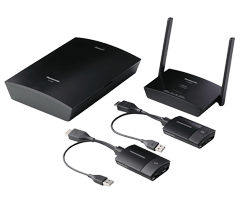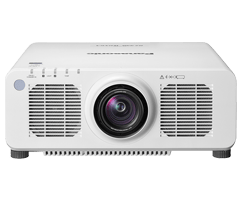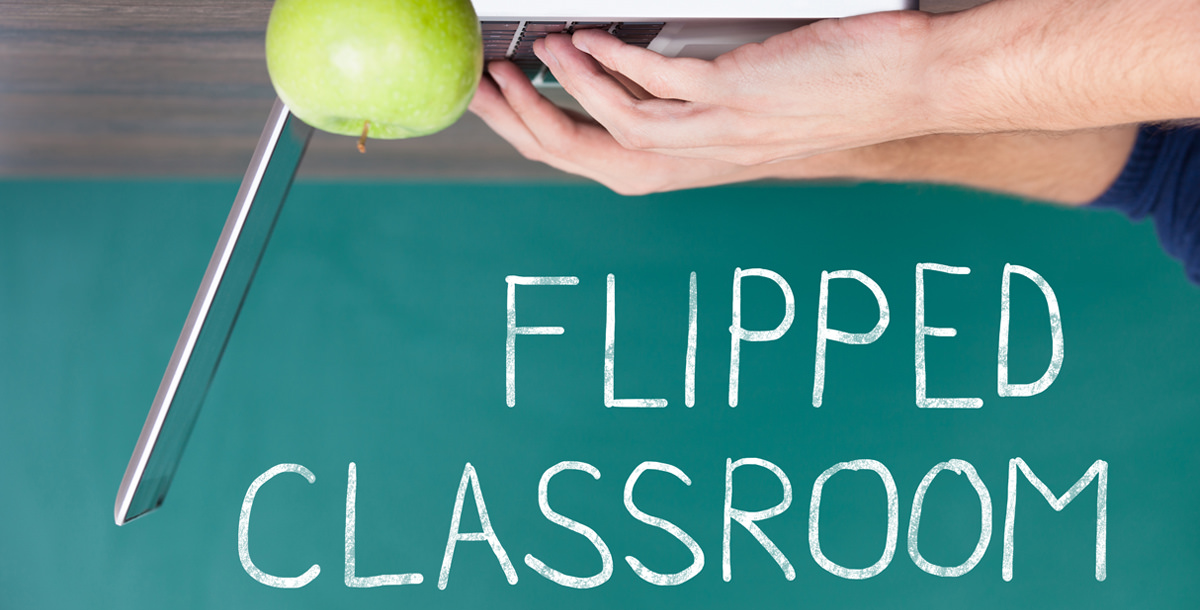
What is a Flipped Classroom?
A flipped classroom refers to an advanced educational method that began in the United States in the late 2000s.
Traditionally, the course contents learned in school are viewed in advance with videos at home. In actual classrooms, more advanced issues related to its content are tackled and discussed with a group, and it is a lesson method that aims to retain knowledge and foster applied skills.
Therefore, flipped classrooms are just a "reversal" of this traditional lesson style. Video teaching materials are used for preparations for so-called “lessons” in the home, and exercises that are normally treated as “homework” and an exchange of opinions related to the learning content are carried out during class time at a school. In other words, the term, “flipped classroom” was given because the learning input and place of output are flipped and lessons that were traditionally received in a classroom are received at home. This was an experiment that began in the United States in the 2000s and is currently attracting attention. If it can be operated properly, major learning achievements can be expected, but there are also several challenges to overcome. Let’s take a detailed look at the background of the development of flipped classrooms, their advantages and disadvantages and the procedures to carry them out.
Education Method that “Flips” the Teaching Style
Behind the birth of the flipped classroom was the rapid spread of ICT such as the Internet, PCs, tablet terminals and smartphones which led to a significant change in the educational field. In a flipped classroom, there is no need for teachers to conduct lectures while writing on a blackboard in front of their students. It has become possible to develop active learning by watching the lecture in advance with a video and carrying out collaborative learning in the actual classroom. It was mentioned earlier that a flipped classroom is characterized by “flipping” lectures at schools to viewing the lecture content at home, but this means that teachers will take on the role as a guide or facilitator to get close to the students and deepen their learning instead of being a person who passes on knowledge.
Advantages of a Flipped Classroom
What kinds of advantages does a flipped classroom offer? What are the differences with a traditional classroom?
Let’s list some of the advantages for both students and teachers.
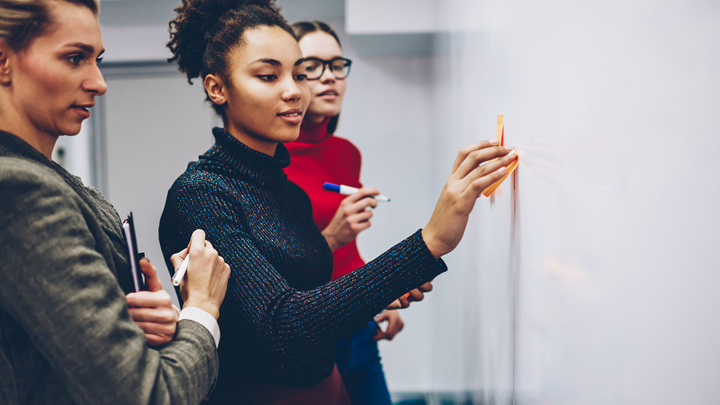
Students can Work Enthusiastically
Traditional classrooms tend to be consistent with unilaterally instilling knowledge, but with a flipped classroom, you can focus on how to utilize the knowledge you have. As a result, it becomes possible to learn according to the abilities and characteristics of each student, and you can challenge difficult problems and development problems.
Use Content at Your Own Pace
With flipped classrooms, students watch recorded lecture content at home in advance. At this time, if there are any unclear points, you can go back and review it or use it for review by watching it repeatedly. As a result, the efficiency of the lesson itself is greatly improved.
In Addition to Learning Effects, Problem-Solving Skills and Cooperation are also Improved
Students will bring the tablet home and take the lesson after watching the video training materials. By reviewing basic knowledge and main points, discussions and group work will increase in the classroom, so in addition to being able to deepen your understanding of knowledge, you can set aside time for collaborative learning. Improved communication skills and cooperation can be expected such as organizing your thoughts and acquire the skills to conduct discussions.
Teachers Will be Able to Understand the Situation of Students
For teachers, there will be more time to communicate with students in the classroom, so you will be able to keep an eye on each student, such as where the students are stumbling or where they excel at.
Disadvantages of a Flipped Classroom
Flipped classrooms have several disadvantages. This can be a burden for both teachers and students, as well as problems with digital equipment. When incorporating a new flipped classroom model, it is necessary to consider the following disadvantages.
Increased Burden on Students
By watching the course content at home in advance, more time will be spent on learning. Also, for students with a low motivation for learning, how to keep them motivated to self-study is a challenge.
Eliminating the Digital Divide Is Essential
In order to carry out a flipped classroom, it is necessary for each household to have digital equipment and an Internet environment. For schools that do not meet these conditions, support is required such as renting out tablet terminals, PCs and Wi-Fi equipment.
Preparation Time Will Increase for Teachers
When shooting course materials on your own, it will be necessary to examine the content and conduct recording work. Even when using external content from video websites, work to find appropriate course materials is required.
In order to give effective guidance during an actual class, there are various preparations such as setting questions to check their level of understanding and thinking about a lesson plan, and the burden will increase in terms of time.
How to Proceed with a Flipped Classroom
Students participating in the flipped classroom model will follow the following steps. Conducting a lecture in advance about the purpose and advantages of a flipped classroom is essential
What Students Will Do at Home
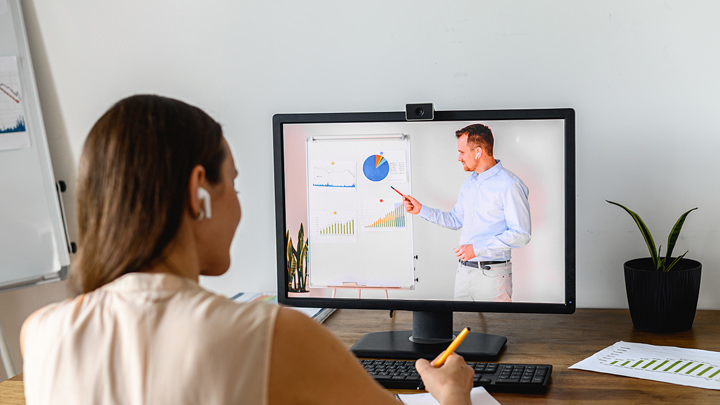
Watch the online lecture
Watch the lecture video specified by the school at home. You can watch the parts that you don’t understand as many times as you want and ask questions during the online discussion or in the actual class.
Read Materials And Text
In a flipped classroom, you often read course materials and text used as supplement teaching aids in addition to watching the videos.
Participate in Online Discussions
After watching the video, there are many examples of classes that hold online discussions at a fixed time. It is thought that these case examples will increase especially due to the impact of the COVID-19.
Conduct Research
After watching the assignment videos, research on a given theme is often proceeded independently under the guidance of teachers. These efforts are also thought to be increasing under due to the COVID-19.
What Are the Important Points of a Flipped Classroom?
So far, we have described the procedures for introducing a flipped classroom, but more specific points to note will be introduced below. By knowing these points, creating course materials and developing a curriculum will be even more accurate.
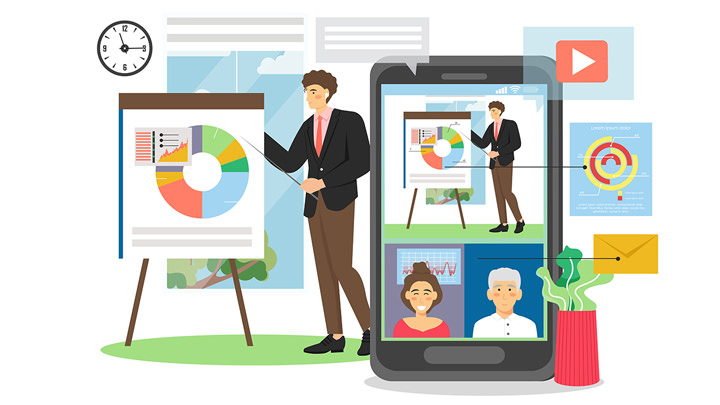
Provide Preparation Course Materials
The videos provided to the students will be created by the teachers or can be found online from external video websites.
Both teachers and students will not be used to it at the beginning, so it is preferable to start with something that has a short recording time and is easy in terms of content. An easy system can be built by using a PTZ camera and combining it with PressIT, making it easier to prepare contents in advance.
Give Motivation to Come Prepared
The videos shown when preparing should be an appropriate length and should draw the attention of the students. Also, explain the significance of the flipped classroom in advance so that everyone prepares well, and provide incentives to the students who did prepare by praising them.
Conduct a Survey in Advance to See if Students have Prepared
One of the secrets to a successful flipped classroom is for students to come to class with the necessary information. First, conduct an easy survey before class and confirm whether everyone prepared. If necessary, teachers will be required to re-instruct the students.
Conduct a Q&A Session
It is important to provide a chance to eliminate confusion by actively conducting Q&A sessions to the students at an early stage of the class. Taking measures such as implementing easy quizzes or reviewing answers using a smartphone or clicker is also effective.
Create a Mechanism to Evaluate Understanding
What you do in the actual class is on a case-by-case basis depending on the teaching content, but another method is to ask questions to see whether the students understand the assignment. Exchanging opinions in a group or accepting questions about those answers can be a starting point for lesson activities.
It is important to prepare to be able to determine how much the students understand and if there are any areas that have not progressed through these activities.
Provide High-Level Activities in the Classroom
One of the basics of the flipped classroom is to spend time on activities to encourage deeper learning after the students acquire basic knowledge at home. At this time, it is desirable to set somewhat difficult assignments. Whether working on exercises as a group or on your own, the learning effects cannot be obtained unless it is a somewhat high-level theme, and it can cause students to lose interest.
Effective Class Methods
Active Learning
Active learning is the key to having students stay interested in the course materials during class. Effectively use time that doesn’t need to be spent on lectures and use methods such as working with pairs or groups to increase the learning effects.
Fishbowl Practice
Fishbowl is a technique to prompt deeper discussion and enable participants to share the content more deeply. By sitting in the middle of a circle formed by students and solving problems, discussing and conducting activities such as executing tasks, the effects of learning can be enhanced.
Role-Play
For complex topics, you can get to the heart of the problem by role-playing and having students express different perspectives.
Specifically, give students a role and have them confront each other in debates and discussions.
Furthermore, in order to deepen their thinking, changing roles in the middle of the exercise and having students experience new perspectives is also effective.
Role of the AV Manager Who Supports the Flipped Classroom
The role of the AV manager is important to proceed with a flipped classroom. Some universities have AV managers with expertise in audio-visual equipment. They are often responsible for conducting maintenance so that the devices can be used smoothly by students and teachers in school and creating rules such as usage methods. Here will be introducing what kind of support the AV manager provides in a flipped classroom.
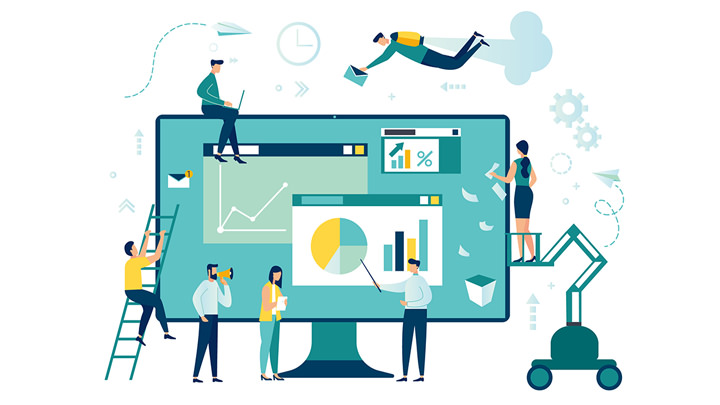
Supporting Video Shooting
If the teacher shoots the course materials on their own, the AV manager is required to provide equipment and technical support.
Especially on the hardware side, choosing the right equipment, choosing the LMS (Learning Management System) and maintaining a communication environment are essential. They should discuss what kind of lesson content will be recorded, how long it is, how the shooting data will be distributed and where to shoot with the teacher and try to eliminate any problems in advance.
Support in the Classroom
In the classroom, it is assumed that parts of the video will be replayed, or assignment materials will be projected.
It is necessary to conduct a meeting with the teacher in advance and prepare the course materials that will be required in class, such as a projector, screen, large display or clicker.
Because class responsiveness is also required, laser light source projectors that can start-up in a few seconds can be used to prevent limited lecture time, and there is no need to worry lectures being interrupted due to the projector lamp going out.
If you have an interactive large display that will make it easier for teachers to point to the content, class efficiency and comprehension will increase dramatically. High-quality lectures can be smoothly conducted with simple operation with a vision presenter that can be controlled with a tablet, an AV control system that integrates the functions of multiple devices and a digital wireless microphone. It is possible to build a system at a low cost with a simple configuration that reduces the equipment to prepare.
It is also necessary to check the communication environment in advance and confirm whether everyone can access the Internet at once.
When thinking that a majority of students use smartphones, tablet terminals and PCs to submit reports and for research, it is important for these devices to be able to be easily connected to a projector or display. When conducting presentations during class, problems often occur such as not being able to display content from these devices onto a display or screen.
Presentation systems that can easily display the presenter’s materials wirelessly can be used to solve these problems. This is a system that you want to consider for smooth operation for classes and research presentations.
Examples of Classes in Universities
With flipped classrooms, students can study at home by watching videos of the lectures to increase the freedom of content to be tackled in face-to-face lessons.
As a result, the ingenuity of teachers can make the classes more creative.
Several practical examples will be introduced below.
Example of a Medical Class
Create and distribute short videos about medical topics learned in class. Students were asked to watch them in advance, and in the actual class, it was possible to create interactive content that focused on case studies and hands-on practice
Example of an English Reading omprehension Class
Study the interpretation points, elements of English grammar and information about the background of the themes with videos, PowerPoint and course materials. It has become possible to confirm the important points and tackle more advanced issues in class.
Example of a Physics Class
In the example of a physics classroom at a certain university, the pre-lecture video was not specially created by the teacher, and was instead provided on an online learning platform. Students were able to watch the videos before class and answer questions and write down any questions that came up.
In the class, the students deepened their understanding of the information obtained from the videos through group discussions and interactive simulations.
Example of a Numerical Analysis Method Class
For the pre-lecture materials, the videos and course material documents were specified. Before coming to class, the students completed an online quiz at home. During the reading session during class, concept questions and exercises were distributed.
During this time, the teacher and two teaching assistants provided support for problems that students may face. The teacher also implemented mini lectures on some topics that students may find difficult to handle on their own.
Example of a Flipped Classroom Plan
The “FLIP” concept devised by Elizabeth Trach is helpful when planning a flipped classroom. By referring to this model while applying it to your school’s curriculum, an even more effective approach is possible.
Four Pillars (FLIP)
Elizabeth Trach presented an article titled, “A Beginner's Guide to Flipped Classroom” on schoology.com. She presented the “FLIP” concept as four points to create a successful flipped classroom. The following is a summary of this concept.
F: Flexible Learning Environment
When you eliminate traditional lecture, you also lose the static rows of seating in favor of flexible arrangements. Furniture should be modular and allow for a variety of group and individual work. Likewise, the timing of lessons needs to be flexible to allow for students to fully explore a topic and understand it at their own pace.
L: Learning Culture
Instead of traditional teacher-centric learning, the flipped classroom puts students at the center of the lesson. Students guide the pace and style of learning, and instructors play the role of the "guide on the side."
I: Intentional Content
Instructors who embraced the flipped learning model are always on the lookout for ways to maximize their classroom time so that students are actively engaged in learning and hands-on practice. This approach requires prioritizing lessons that work in such a model and figuring out ways to encourage learners to work independently.
P: Professional Educator
The flipped model requires instructors to constantly monitor their students in order to identify who needs help with what and why. Instructors need to be responsive and flexible, and they must understand that this highly active style of teaching takes great pedagogical skill.
Combination with Other Educational Methods
By combining the flipped classroom with other educational methods, even bigger learning effects can be expected. Flipped classrooms, which enable you to have a lot of free time in class by preparing in advance, may be a clue to solving various problems of each curriculum.
Flipped Classroom + Guidance Between Students (Peer Instruction)
Peer instruction is an active learning technique that incorporates discussions between students.
First, ask multiple choice questions and have a student answer them using a clicker. Next, let them discuss their answer with other students around them and collect the answers again. Lastly, the teacher will show the correct answer and explain it.
By introducing peer instruction in a class, it can enhance the students’ sense of participation and increase their retention of knowledge.
By adding this technique to the flipped classroom, the lesson content can be further enhanced.
Flipped Classroom + Adaptive Learning
Gamification refers to incorporating game elements into social activities and service development, and is in the process of being introduced to educational fields. Games are essentially problem-solving oriented, and they make it easy for students to feel that they cleared the assignments and feel a sense of growth, and the effects of leading to continuous learning can be expected.
There are many learning apps and learning software that use this concept, and it is said that it is also effective to use them as course materials for flipped classrooms.
Flipped Classroom + Gamification
Adaptive learning refers to providing optimized learning content according to the students’ understanding and progress.
By combining an educational approach such as adaptive learning with the flipped classroom, teachers can gain information about the areas that students are proficient in and areas that are still lacking or need improvement. This information can support decisions about the class composition and policies to optimize lessons for students.
Flipped Classroom + Cooperative Learning
Cooperative learning is a technique to maximize the effectiveness of mutual learning by working together with a small group of people to tackle assignments. Combining it with a flipped classroom and incorporating in-group discussions on the subject of the day into the lesson has the effect of encouraging the retention of the learned content and improve communication skills.
Flipped Classroom + Inclusive Classroom
An inclusive classroom refers to a mechanism where students with and without disabilities can learn together with the purpose of respecting human diversity, developing the mental and physical abilities of students with disabilities and enabling their effective participation in society.
Flipped classrooms are beneficial for students with and without disabilities and inclusive classrooms can be expected to have the effect of changing the perception of disabilities and reducing prejudice.
Global Expansion with the Spread of ICT
Flipped classrooms are intended to increase student engagement with class by
“flipping” the input and output. The number of services that provide educational video sources is increasing, and is expected to spread diverse education.
Although the number of cases is increasing primarily in schools in the United States, the use of flipped classrooms is expected to increase in other countries with the advancement of ICT infrastructure such as the Internet environment in households in the future.



